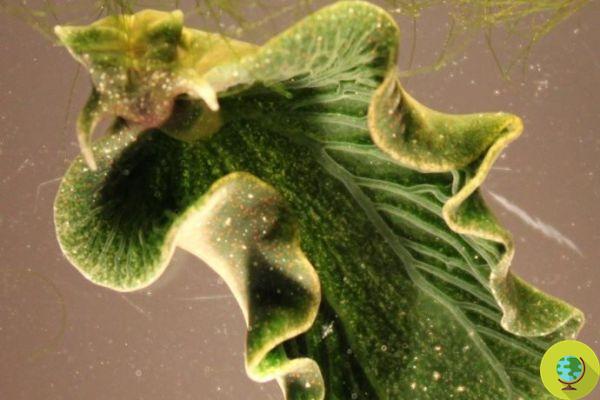
Its nourishment is the light of the sun. And it's not a plant. A special sea snail, perhaps envious of this typical ability of plants, has decided to imitate them, literally stealing the plastids from the algae, involved in the photosynthesis process.
He is about to end up run over, his mother saves him
Its nourishment is the light of the sun. And it's not a plant. A special sea snail, perhaps envious of this typical ability of plants, has decided to imitate them, literally stealing the plastids involved in the photosynthesis process from the algae.
This was revealed by a study conducted by researchers at Rutgers University in New Brunswick, according to which this snail can appropriate the raw material from algae to maintain its "solar-powered" lifestyle.
Known as Elysia chlorotica, the sea snail feeds on the sun and has found an excellent solution to do so: it subtracts millions of plastids greens with algae. The latter are tiny organs that function like real solar panels. Plastids are not digested but stored in the snail's gut lining.
This mollusk lives in the area between Nova Scotia, Canada and the island of Martha's Vineyard, but also in Florida and can grow up to 5cm in length. Young snails eat the Vaucheria Costiea alga and become photosynthetic.
Photosynthesis usually occurs when algae and plants use sunlight to create chemical energy (sugars) from carbon dioxide and water. Seaweed plastids are photosynthetic organelles (like organs in animals and people) with chlorophyll, a green, light-absorbing pigment.
This particular alga is an ideal food source for snails as its body is similar to a long tube containing nuclei and plastids. The lsea umac makes a hole in the outer cell wall, sucks up the contents of the cell and captures all plastids alkali.
To find out, the Rutgers University team used RNA sequencing. The data showed that the snail is capable of protecting plastids from digestion and activates specific genes. According to the researchers, Elysia chlorotica after stealing plastids, stop feeding and survive thanks to photosynthesis for the next 6-8 months.
This is an incredible result, similar to adding solar panels to your body.
"It is a remarkable feat because it is very rare for an animal to behave like a plant and survive only thanks to photosynthesis", he said Debashish Bhattacharya, senior author of the study and professor in the Rutgers-New Brunswick Department of Biochemistry and Microbiology. “The broader implication is in the field of artificial photosynthesis. If we can understand how the snail stores the stolen plastids and isolates them to fix the carbon without the core of the plant, then maybe we can do it too by devising green systems to create bioproducts or energy. The existing paradigm is that to produce green energy, we need the plant or the alga to manage the photosynthetic organelle, but the snail shows us that this is not always the case ”.
The research was published on Molecular Biology and Evolution.
READ also:
- Latro lamp, the lamp powered by the photosynthesis of algae
- The mysterious albino sequoias that survive without chlorophyll by helping nearby trees
- The artificial leaf that produces oxygen: made of silk and chlorophyll
Francesca Mancuso


























